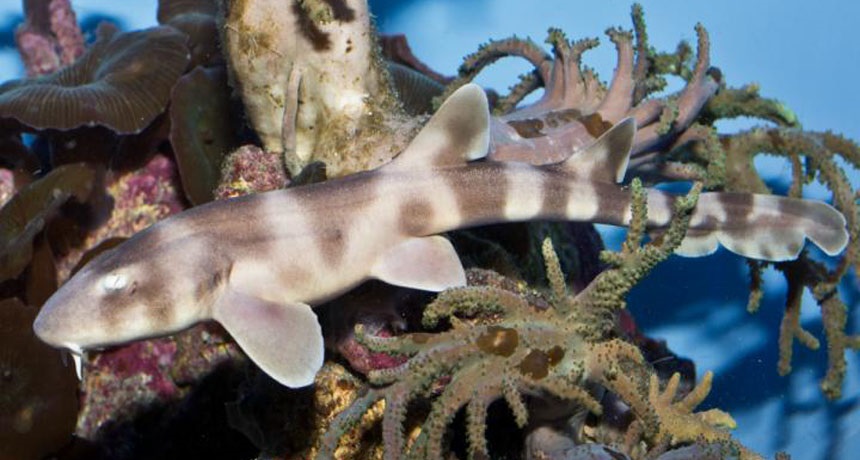Shark: Who’s your daddy?
Mom and dad hadn’t shared a tank for almost 4 years

This young shark was born in a tank containing three female sharks, but no males. A genetic study showed that the pup does have a dad, though who he is remains a mystery.
California Academy of Sciences
In January 2012, curators at the Steinhart Aquarium of the California Academy of Sciences (CAS) got a big surprise. A live brownbanded bamboo shark emerged from an egg case in a fish tank that had no potential dads. Moisés A. Bernal and other scientists with CAS in San Francisco wanted to find out how this was possible. The tank held three females but no males. Genetics identified one female as the likely mom. Then the scientists reviewed records for her past companions. The last time she had been with a male was at least 45 months — almost 4 years — before she released her egg into the tank.
That’s a record for sharks. Bernal and his colleagues reported their findings December 28 in the Journal of Fish Biology.
The Steinhart Aquarium got the tank’s three female sharks in September 2007. They came from an aquarium in Long Beach, Calif. At the Long Beach facility they had shared a tank with male brownbanded bamboo sharks.
After leaving Long Beach, the female sharks spent a year in a temporary home. When new facilities at San Francisco’s Golden Gate Park opened up, the three females moved in. There, they shared a tank with female blacktip reef sharks and a male Javanese cownose ray. (Rays are members of the shark family and resemble flattened sharks with wings.) In January 2011, the brownbanded bamboo sharks laid egg cases — nicknamed mermaid’s purses. Inside each one was a single egg. Eleven months later, two of those egg cases showed signs of a live, developing shark inside. One hatched on January 21, 2012.
It seemed to make no sense. So the researchers puzzled over how this shark pup came to be.
Could the ray have been the pup’s dad? The scientists rejected that idea pretty quickly: The two species are so distantly related that it should have been nearly impossible for them to mate and produce live offspring.
Maybe the pup had no dad. The females of certain animals sometimes can produce offspring from an unfertilized egg. This is called parthenogenesis (PAR-then-oh-JEN-eh-sis). And this type of reproduction has occurred before in at least three types of sharks: the bonnethead, blacktip and whitespotted bamboo species. This unusual strategy can sometimes make sense, biologists argue. It lets a female produce young even when there are no males around. But that didn’t happen here, Bernal’s team concluded. DNA tests showed that although the pup was closely related to one female — its likely mom — it also contained genetic material from another individual. That meant it indeed had a dad.
Who that dad is and where he is now remains a mystery. “Unfortunately,” Bernal’s group reports, “there is no information on the whereabouts of the sharks that shared the enclosure with the three females from this study.”
It’s just another example of the wonders of biology — like last year’s “Octomom.” She was an octopus that spent a world-record 4.5 years guarding a clutch of eggs on the seafloor off of California, at a depth of 1,397 meters (more than eight-tenths of a mile).
Power Words
fertilize The merging of a male and a female reproductive cell (egg and sperm) to set in create a new, independent organism.
genetic Having to do with chromosomes, DNA and the genes contained within DNA. The field of science dealing with these biological instructions is known as genetics. People who work in this field are geneticists.
parthenogenesis An unusual form of reproduction where animals sometimes produce healthy offspring from an unfertilized egg.
rays (in biology) Members of the shark family, these kite-shaped fish species resemble a flattened shark with wide fins that resemble wings.
sharks A family of primitive fishes that rely on skeletons formed of cartilage, not bone. Like skates and rays, they belong to a group known as elasmobranchs. Then tend to grow and mature slowly and have few young. Some lay eggs, others give birth to live young.







